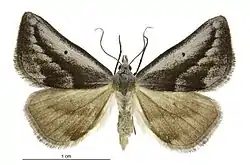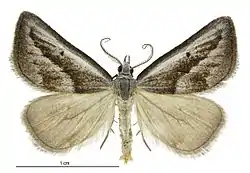| Adeixis griseata | |
|---|---|
 | |
| Female specimen | |
 | |
| Male specimen | |
| Scientific classification | |
| Kingdom: | |
| Phylum: | |
| Class: | |
| Order: | |
| Family: | |
| Genus: | |
| Species: | A. griseata |
| Binomial name | |
| Adeixis griseata | |
| Synonyms[1] | |
| |
Adeixis griseata (also known as the swamp looper) is a species of moth of the family Geometridae.[2] It is endemic to New Zealand and has been collected in the North, South and Chatham Islands. This species inhabits poorly drained or swampy areas. As at 2017 the host plant of this species is unknown however it has been hypothesised that the host plant may be Schoenus brevifolius or another common sedge. Adults have been observed on the wing from October until January.
Taxonomy
This species was first described by George Vernon Hudson in 1903 from a specimen collected by Alfred Philpott at Seaward Moss in Southland and named Dichromodes griseata.[3] There was some debate between taxonomists as to whether this species was distinct from the Australian species Adeixis inostentata.[2] However, in 1920, after comparing specimens of both species, Philpott concluded it was distinct enough to be regarded as its own species.[4][2] Louis B. Prout placed this species within the genus Adeixis in 1910.[5] The syntype specimens are not held in Te Papa but J. S. Dugdale hypothesised that one of the syntypes may be held at the Natural History Museum, London under the species name Paragyrtis inostentata (now known as Adeixis inostentata).[2] In 2019 the molecular phylogeny of this species was studied.[6]
Description

The forewings of A. griseata are silver grey in colour with a small disk-shaped dot as well as with dark brown or blackish triangular shaped shading from the middle of the base of the forewing to its apex and a much smaller brown triangular shaped shading below this. The hind-wings are grey coloured tinged with yellow brown.[7] When at rest its body position tends to be head downward.[8] Hudson regarded this species as being extremely variable in the intensity of its markings and the depth of its colouring.[7]
Range
Specimens have been collected not only at the type locality of Seaward Downs but also in other locations in the South Island such as Lake Manapouri,[4][9] as well as localities in the North Island such as in Whangarei,[10] Waimarino, Raetihi, Ohakuni and Kaitoki.[7] A. griseata has also been found on the Chatham Islands.[7]
Behaviour
The adults of this species have been observed on the wing from October to January.[11]
Habitat
A. griseata tends to inhabit poorly drained or swampy areas with sedges, rushes, Gleichenia, and native shrubs such as Pittosporum and Coprosma.[12] However as at 2017 the host plants of A. griseata is unknown.[13] It has been hypothesised that the host plant may be Schoenus brevifolius or another common sedge.[14]
References
- 1 2 "Adeixis griseata (Hudson, 1903)". www.nzor.org.nz. Landcare Research New Zealand Ltd. Retrieved 1 February 2017.
- 1 2 3 4 Dugdale, J. S. (1988). "Lepidoptera - annotated catalogue, and keys to family-group taxa" (PDF). Fauna of New Zealand. 14: 191. ISSN 0111-5383. Archived from the original (PDF) on 27 January 2019. Retrieved 1 February 2017.
- ↑ Hudson, George Vernon (1903). "On Some New Species of Macro-lepidoptera". Transactions and Proceedings of the New Zealand Institute. 35: 244–245 – via Biodiversity Heritage Library.
- 1 2 Philpott, Alfred (1920). "Notes and descriptions of New Zealand Lepidoptera". Transactions and Proceedings of the New Zealand Institute. 53: 337–342 – via Biodiversity Heritage Library.
- ↑ Prout, L.B. 1910: Lepidoptera Heterocera far. Geometridae subfam. Oenochrominae. Genera insectorum, fasc. 104. p. 22
- ↑ Murillo-Ramos, Leidys; Brehm, Gunnar; Sihvonen, Pasi; Hausmann, Axel; Holm, Sille; Reza Ghanavi, Hamid; Õunap, Erki; Truuverk, Andro; Staude, Hermann; Friedrich, Egbert; Tammaru, Toomas; Wahlberg, Niklas (27 August 2019). "A comprehensive molecular phylogeny of Geometridae (Lepidoptera) with a focus on enigmatic small subfamilies" (PDF). PeerJ. 7: e7386. doi:10.7717/peerj.7386. ISSN 2167-8359. PMC 6716565. PMID 31523494.
- 1 2 3 4 Hudson, George Vernon (1928). The butterflies and moths of New Zealand. Wellington, N.Z.: Ferguson & Osborn Ltd. pp. 133–134. Retrieved 1 February 2017.
- ↑ Crowe, Andrew (2002). Which New Zealand insect? : with over 650 life-size photos of New Zealand insects. Auckland, N.Z.: Penguin. p. 20. ISBN 0-14-100636-6. OCLC 52477325.
- ↑ Clarke, Charles E. (1934). "The Lepidoptera of the Te Anau-Manapouri Lakes Districts". Transactions and Proceedings of the New Zealand Institute. 63: 112–132. Retrieved 1 February 2017.
- ↑ Patterson, S. C. (1930). "List of Lepidoptera of Whangarei". Transactions and Proceedings of the New Zealand Institute. 61: 554–561 – via National Library of New Zealand.
- ↑ "Swamp Looper (Adeixis griseata)". iNaturalist. Retrieved 11 April 2023.
- ↑ Holloway, J. D. (1979). A Survey of the Lepidoptera, Biogeography and Ecology of New Caledonia. Springer Science & Business Media. p. 260. ISBN 9789400995970. Retrieved 1 February 2017.
- ↑ "Notes on families and subfamilies of larger moths included in this Guide | Larger moths of New Zealand | Landcare Research". www.landcareresearch.co.nz. Landcare Research New Zealand Ltd. Archived from the original on 19 April 2017. Retrieved 1 February 2017.
- ↑ R. J. B. Hoare (February 2011). "Lepidoptera of gumland heaths — a threatened and rare ecosystem of northern New Zealand" (PDF). New Zealand Entomologist. 34 (1): 67–76. doi:10.1080/00779962.2011.9722212. ISSN 0077-9962. Wikidata Q54578051.